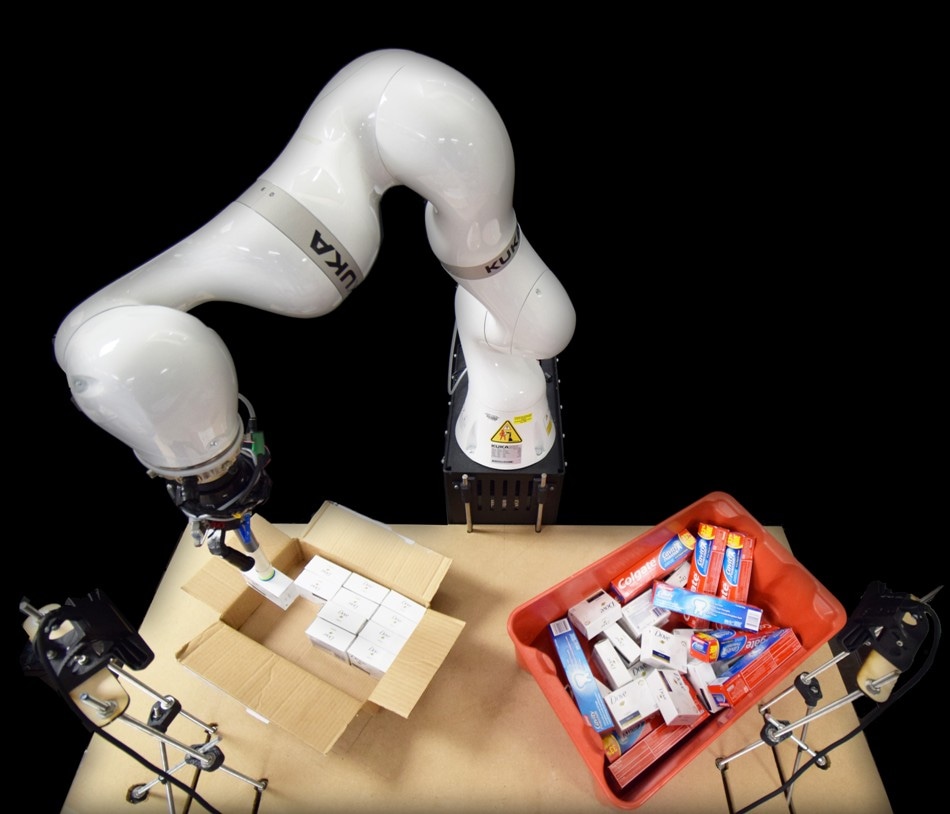Jun 28 2019
Computer scientists at Rutgers used artificial intelligence to regulate a robotic arm that delivers a more efficient way to pack boxes, saving businesses money and time.
 An automation workspace with a Kuka robotic arm and a bin containing a pile of objects that need to be tightly packed into a shipping order box. The Rutgers robotic packing system is designed to overcome errors during packing. (Photo credit: Rahul Shome/Rutgers University-New Brunswick)
An automation workspace with a Kuka robotic arm and a bin containing a pile of objects that need to be tightly packed into a shipping order box. The Rutgers robotic packing system is designed to overcome errors during packing. (Photo credit: Rahul Shome/Rutgers University-New Brunswick)
“We can achieve low-cost, automated solutions that are easily deployable. The key is to make minimal but effective hardware choices and focus on robust algorithms and software,” said the study’s senior author Kostas Bekris, an associate professor in the Department of Computer Science in the School of Arts and Sciences at Rutgers University-New Brunswick.
Bekris, Abdeslam Boularias, and Jingjin Yu, both assistant professors of computer science, formed a team to handle the numerous aspects of the robot packing problem in an integrated way through 3D perception, hardware, and robust motion.
The researchers’ peer-reviewed study was recently published at the IEEE International Conference on Robotics and Automation, where it was a finalist for the Best Paper Award in Automation. The research corresponds with the growing trend of deploying robots to carry out retail, logistics, and warehouse tasks. Improvements in robotics are accelerating at an extraordinary pace because of machine learning algorithms that allow for constant experimentation.
Securely packing products picked from a disorderly pile remains essentially a manual task, even though it is important to warehouse efficiency. Automating such tasks is crucial for companies’ competitiveness and allows employees to pay attention to less tedious and physically demanding work, according to the Rutgers team.
The study concentrated on taking objects from a bin and placing into a small shipping box and securely arranging them. This is a more challenging task for a robot than merely picking up an object and dropping it into a box.
The scientists prepared algorithms and software for their robotic arm. They used visual data and a basic suction cup, which also acts as a finger for pushing objects. The resulting system can upset objects to get an appropriate surface for picking them. Besides, it uses sensor data to tug objects toward a specific area and push objects together. During these maneuvers, it uses real-time tracking to detect and prevent potential errors.
As the study concentrated on packing cube-shaped objects, the following step would be to investigate packing objects of different sizes and shapes. Another step would be to look into automatic learning by the robotic system after it is given a particular job.
The lead authors are Rahul Shome and Wei N. Tang, doctoral students in the Department of Computer Science. Co-authors included doctoral students Changkyu Song and Chaitanya Mitash, as well as Hristiyan Kourtev, a scientific programmer at the Rutgers Center for Cognitive Science. The study received support via research contracts and grants from JD.com's Silicon Valley research center and the National Science Foundation.
Robust Product Packing for Warehouse Automation
This YouTube video shows a Kuka robotic arm tightly packing objects from a bin into a shipping order box (five times actual speed).